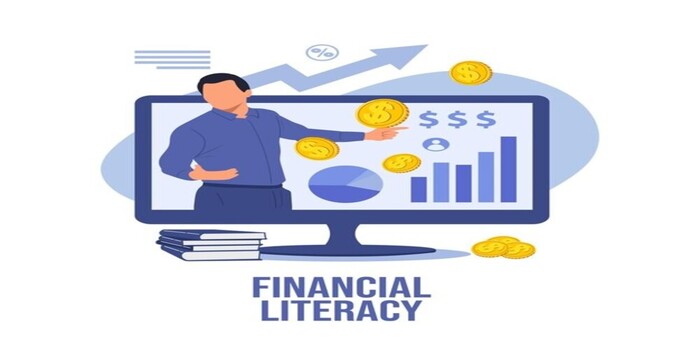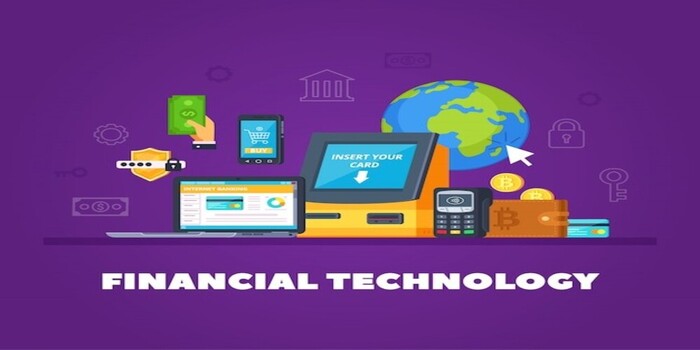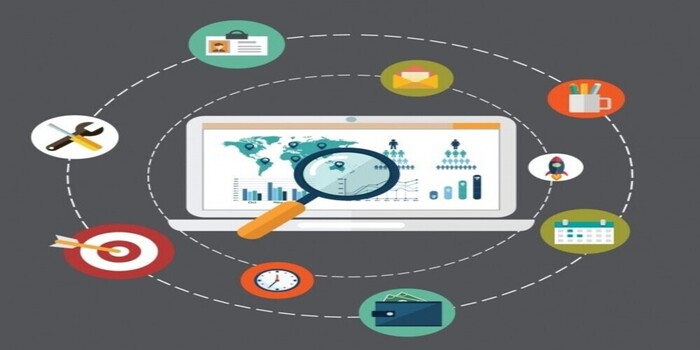
Have you been trying to get your finances in order, but feeling overwhelmed with how to begin? Financial literacy can be a daunting endeavor for many of us, and it doesn’t help that the world of finance is constantly changing. Nowadays, financial technology – or “fintech” – can play an integral role in helping individuals develop long-term positive money habits! By empowering ourselves with greater understanding and knowledge about today’s financial landscape – an understanding made possible by modern fintech innovations – we can become more financially literate and empowered citizens. In this blog post, I’ll help you explore the exciting possibilities available through incorporating fintech into our financial journeys.
Table of Contents
Introducing Fintech and Its Potential to Improve Financial Literacy

Fintech, short for financial technology, refers to the application of technology to enhance and automate financial services. It encompasses a wide range of innovations and solutions that aim to improve various aspects of the financial industry, including banking, payments, investments, insurance, and more.
Financial literacy refers to the knowledge and understanding of various financial concepts and products, as well as the ability to make informed decisions about personal finances. It plays a crucial role in empowering individuals to manage their money effectively, make sound financial decisions, and achieve their financial goals.
Fintech offers several ways to address this issue and improve financial literacy:
- Digital Financial Education: Fintech platforms provide accessible and user-friendly digital resources, such as mobile apps and websites, to educate individuals about financial topics. These platforms offer interactive tools, tutorials, articles, and videos to enhance financial knowledge.
- Personalized Financial Guidance: Fintech solutions leverage advanced algorithms and data analytics to provide personalized recommendations and guidance tailored to an individual’s financial situation and goals. These tools can help users with budgeting, saving, investing, and managing debt.
- Gamification: Fintech applications often incorporate gamification elements to make learning about finance engaging and enjoyable. Gamified platforms use interactive quizzes, challenges, and rewards to incentivize users to improve their financial knowledge and skills.
- Access to Financial Services: Fintech has expanded access to financial services for underserved populations, including those with limited financial literacy. By leveraging technology and digital platforms, fintech companies offer affordable financial products. For instance, mobile banking apps provide easy access to basic banking services, while investment apps offer low-cost investment options.
- Data Visualization and Tracking: Fintech tools often provide visually appealing and intuitive interfaces to help users understand and track their financial data effectively. Through charts, graphs, and other visual representations, individuals can visualize their spending habits, savings progress, investment performance.
How Fintech Can Help Consumers Become Financially Savvy

Fintech plays a crucial role in helping consumers become financially savvy by providing them with tools, resources, and services that promote financial knowledge and responsible money management. Here are several ways in which fintech can assist consumers in becoming financially savvy:
- Budgeting and Expense Tracking: Fintech platforms offer user-friendly budgeting tools that enable consumers to create and track their budgets effectively. These tools categorize expenses, provide spending insights, and send notifications or alerts when users exceed their budget limits.
- Saving and Investing: Fintech provides accessible and user-friendly platforms for saving and investing. Through automated savings apps, consumers can set up automatic transfers from their checking accounts into savings or investment accounts. Fintech tools also offer micro-investment options, allowing individuals to invest small amounts of money in diversified portfolios.
- Financial Planning and Goal Setting: Fintech platforms offer financial planning tools that help consumers set and achieve their financial goals. These tools take into account factors such as income, expenses, debt, and investment returns to create personalized financial plans. Consumers can track their progress, receive recommendations, and adjust their strategies accordingly.
- Access to Credit and Loans: Fintech has disrupted the lending industry by introducing alternative lending platforms and peer-to-peer lending networks. These platforms leverage technology and data analysis to provide quick and convenient access to credit, especially for individuals with limited credit history.
- Enhanced Security and Fraud Protection: Fintech companies prioritize security measures to protect consumer data and transactions. They employ encryption, two-factor authentication, biometric authentication, and other advanced security features to ensure the safety of financial information.
- Financial Wellness Tools: Fintech platforms often include financial wellness features that provide holistic support for consumers’ financial well-being. These tools may include credit score monitoring, debt management assistance, retirement planning calculators, and insurance coverage analysis.
Examples of Innovative Fintech Tools and Their Applications

Here are some examples of innovative fintech tools and their applications:
- Robo-Advisors: Robo-advisors are automated investment platforms that use algorithms to provide personalized investment recommendations based on an individual’s goals, risk tolerance, and investment horizon. They offer low-cost investment options, diversification strategies, and rebalancing services, making investing more accessible and affordable for a broader range of investors.
- Peer-to-Peer (P2P) Lending Platforms: P2P lending platforms connect borrowers directly with individual lenders, cutting out traditional financial institutions. These platforms leverage technology to facilitate loan origination, credit assessment, and repayment processes.
- Digital Wallets: Digital wallets enable users to store, manage, and transact with their digital currencies or traditional fiat currencies securely through mobile apps or online platforms. They allow users to make payments, transfer money, and even engage in contactless transactions using near-field communication (NFC) technology.
- Blockchain and Cryptocurrencies: Blockchain technology, the underlying technology behind cryptocurrencies like Bitcoin and Ethereum, has revolutionized the way transactions and data are stored and verified. Blockchain provides transparent, decentralized, and secure transactions, which can be applied to various fintech applications.
- Open Banking Platforms: Open banking refers to the practice of sharing financial data securely and with user consent between different financial institutions and third-party providers through application programming interfaces (APIs).
- Crowdfunding Platforms: Crowdfunding platforms enable individuals or businesses to raise funds from a large number of people through online campaigns. These platforms connect project creators with potential investors or donors, allowing them to showcase their projects and receive financial support.
- Regtech (Regulatory Technology) Solutions: Regtech refers to the use of technology to streamline and automate compliance processes for financial institutions. These solutions help companies navigate complex regulatory requirements, monitor transactions for potential risks, and ensure compliance with anti-money laundering (AML) and Know Your Customer (KYC) regulations.
Exploring the Benefits of Financial Education for Consumers

Financial education plays a vital role in empowering consumers to make informed financial decisions, improve their financial well-being, and achieve their long-term goals. Here are several key benefits of financial education for consumers:
- Improved Financial Decision-Making: Financial education equips consumers with the knowledge and skills needed to make informed decisions about saving, budgeting, investing, borrowing, and managing debt. It helps them understand complex financial concepts, such as interest rates, credit scores, and investment strategies.
- Increased Financial Confidence: Financial education instills confidence in consumers by demystifying the complexities of personal finance. It empowers individuals to take control of their financial lives, tackle financial challenges, and navigate through different stages of life with confidence.
- Enhanced Money Management Skills: Financial education equips consumers with practical money management skills, such as budgeting, tracking expenses, and setting financial goals. It helps individuals develop responsible spending habits, prioritize financial needs, and live within their means.
- Financial Goal Achievement: Financial education helps consumers define and work towards their financial goals. It encourages individuals to set short-term and long-term objectives, such as saving for emergencies, buying a home, funding education, or planning for retirement. With the knowledge gained through financial education, consumers can create actionable plans, implement effective strategies, and stay committed to their goals.
- Protection Against Financial Fraud and Scams: Financial education raises consumer awareness about common financial scams, fraudulent practices, and identity theft. By understanding the warning signs and learning how to protect themselves, consumers can avoid falling victim to fraudulent schemes and safeguard their financial assets.
- Promotes Financial Well-being across Generations: Financial education has a positive impact on individuals of all ages, from children to adults. By starting financial education early in life, children develop good money habits, learn the value of saving, and understand the consequences of financial choices.
Examining the Challenges Faced by Low-Income Families and Communities

Low-income families and communities face numerous challenges that can significantly impact their overall well-being and limit their opportunities for economic advancement. Here are some key challenges faced by low-income families and communities:
- Limited Access to Quality Education: Low-income families often face barriers in accessing quality education for their children. They may lack resources for school supplies, tutoring, or extracurricular activities. Inadequate educational opportunities can hinder children’s academic development and limit their future prospects.
- Financial Insecurity: Low-income families often struggle with financial insecurity due to limited income and lack of stable employment. They may live paycheck to paycheck, making it challenging to save for emergencies or invest in their future.
- Limited Access to Healthcare: Low-income families often face challenges in accessing quality healthcare services due to lack of insurance coverage, high healthcare costs, or limited availability of healthcare providers in their communities.
- Food Insecurity: Low-income families and communities may struggle with food insecurity, lacking consistent access to nutritious and affordable food. This can lead to malnutrition, health issues, and hinder the physical and cognitive development of children.
- Limited Job Opportunities and Skills Gap: Low-income communities often face limited job opportunities, especially those with low educational attainment or residing in areas with high unemployment rates. Additionally, there may be a skills gap, where available jobs require qualifications that community members do not possess.
- Limited Access to Financial Services: Low-income families may have limited access to traditional financial services, such as banking, credit, and insurance. This can result in reliance on costly alternative financial services and exclusion from the benefits of the formal financial system.
- Social and Environmental Disadvantages: Low-income communities may face social and environmental disadvantages, such as high crime rates, limited access to green spaces, or exposure to environmental hazards. These factors can negatively impact community well-being and perpetuate systemic inequalities.
Remarks on the Growing Role of Fintech in Financial Literacy

Fintech tools and platforms offer innovative solutions that address the barriers to financial literacy, making financial education more accessible, engaging, and personalized. The benefits of fintech in enhancing financial literacy are far-reaching:
- Accessibility: Fintech platforms provide convenient and user-friendly access to financial education resources, breaking down geographical and time barriers. Users can access educational materials, tools, and personalized guidance through mobile apps or online platforms, empowering them to learn at their own pace and convenience.
- Personalization: Fintech leverages data analytics and algorithms to offer personalized recommendations and guidance based on individuals’ financial situations and goals. This customized approach enables users to receive targeted insights, actionable advice, and relevant financial information tailored to their specific needs, improving their financial decision-making capabilities.
- Engagement: Fintech incorporates gamification elements, interactive features, and social communities to enhance engagement with financial education. By making learning interactive, entertaining, and collaborative, fintech platforms boost user participation and motivation, ultimately leading to a deeper understanding of financial concepts.
- Empowerment: Fintech empowers individuals to take control of their finances by providing tools and resources that promote financial management skills. Budgeting apps, investment platforms, and digital wallets enable users to track their finances, automate savings, and make informed financial decisions, fostering a sense of empowerment and ownership over their financial well-being.
- Inclusion: Fintech has the potential to bridge the financial literacy gap and promote inclusion by reaching underserved populations. By leveraging technology, fintech offers simplified financial products, expands access to banking services, and provides resources in multiple languages, catering to diverse communities that may have limited access to traditional financial services and education.
- Innovation and Adaptability: Fintech continually evolves and adapts to changing consumer needs and technological advancements. It leverages emerging technologies like AI, blockchain, and big data analytics to develop cutting-edge solutions that enhance financial literacy.
Assessing the Impact of Financial Literacy on Personal and Economic Well-being

Financial literacy has a profound impact on both personal and economic well-being, influencing individuals, families, and societies at large. Here, we assess the impact of financial literacy in these areas:
Personal Well-being: Financial literacy directly affects an individual’s personal well-being in several ways:
- a. Financial Security: Financially literate individuals are better equipped to manage their money, budget effectively, and make informed financial decisions. This leads to increased financial security, reduced financial stress, and improved overall well-being.
- b. Goal Achievement: Financial literacy empowers individuals to set and achieve their financial goals. It enables them to prioritize their objectives, make prudent investments, and save for emergencies, education, homeownership, or retirement. As individuals achieve their financial goals, they experience a sense of accomplishment and improved life satisfaction.
- c. Improved Decision-Making: Financially literate individuals possess the knowledge and skills to evaluate financial products, compare options, and choose the most suitable ones. They can make informed decisions regarding investments, insurance, credit, and savings, minimizing the risk of financial pitfalls and maximizing financial opportunities.
- d. Long-term Financial Resilience: Financial literacy equips individuals with the ability to plan for the future and anticipate potential challenges. They are more likely to have emergency funds, retirement savings, and appropriate insurance coverage, which enhances their financial resilience and ability to weather unexpected circumstances.
Economic Well-being: Financial literacy has a broader impact on economic well-being at the societal level:
- a. Reduction in Debt and Bankruptcy: Financially literate individuals are less likely to accumulate excessive debt or fall into bankruptcy. By understanding credit, interest rates, and responsible borrowing, they can manage debt effectively, maintain healthy credit scores, and avoid financial crises.
- b. Increased Savings and Investments: Financial literacy encourages individuals to save and invest, which stimulates personal wealth accumulation and economic growth. Higher levels of financial literacy translate into increased savings rates and more participation in investment markets, leading to capital formation and economic stability.
- c. Enhanced Workforce Productivity: Financially literate individuals tend to make better career choices, negotiate better salaries, and effectively manage their income. This, in turn, contributes to increased workforce productivity and economic growth at the societal level.
- d. Reduced Economic Inequality: Financial literacy plays a crucial role in reducing economic inequality. It equips individuals with the knowledge and skills necessary to break the cycle of poverty, make informed financial decisions, and improve their economic circumstances. As financial literacy levels rise across communities, the wealth gap narrows, promoting more inclusive economic growth.
Analyzing the Challenges and Barriers in Promoting Financial Literacy through Fintech

While fintech has great potential in promoting financial literacy, there are several challenges and barriers that need to be addressed to ensure its effective implementation. Here, we analyze some of these challenges:
- Access to Technology: Fintech relies on digital platforms, mobile apps, and internet connectivity. However, low-income individuals and communities may face challenges in accessing these technologies due to affordability, lack of infrastructure, or limited digital literacy.
- Limited Financial Inclusion: While fintech has the potential to promote financial inclusion, certain groups may still face barriers in accessing fintech services. Unbanked or underbanked individuals may lack the necessary identification, credit history, or documentation required to access fintech platforms.
- Digital Literacy: Fintech tools and platforms may require a certain level of digital literacy to be effectively utilized. Many individuals, particularly older generations or those with limited exposure to technology, may lack the necessary skills to navigate and utilize fintech solutions.
- Trust and Security Concerns: Fintech platforms deal with sensitive financial information, and consumers need to have trust and confidence in these technologies. Concerns related to data privacy, security breaches, and fraudulent activities may hinder the adoption of fintech solutions. Ensuring robust security measures, transparent data practices, and educating consumers about the safety of fintech platforms is crucial in building trust.
- Lack of Standardization and Regulation: Fintech operates in a rapidly evolving and often unregulated landscape. The absence of standardized practices and regulations can lead to varying levels of quality, transparency, and consumer protection. Establishing clear regulatory frameworks that safeguard consumers’ interests while promoting innovation is necessary to ensure the responsible development and deployment of fintech solutions.
- Behavioral Barriers: Financial literacy is not solely about knowledge but also about changing behavior. Even with access to fintech tools and educational resources, individuals may struggle to apply financial knowledge to their daily lives.
Evaluating the Effectiveness of Gamification in Financial Education through Fintech Platforms

Gamification, the use of game design elements in non-game contexts, has gained popularity in financial education through fintech platforms. Here, we evaluate the effectiveness of gamification in financial education:
- Increased Engagement: Gamification in financial education makes the learning process more interactive, enjoyable, and engaging. By incorporating elements like challenges, achievements, leaderboards, and rewards, gamification captures users’ attention and motivates them to actively participate in the learning experience.
- Learning by Doing: Gamification provides a hands-on approach to financial education, allowing users to apply financial concepts in a simulated environment. Through interactive simulations, users can make virtual financial decisions, experience the consequences of their choices, and learn from their mistakes.
- Personalized Learning Paths: Gamification in fintech platforms can adapt to individual users’ progress and offer personalized learning paths. By assessing users’ knowledge, skills, and performance, the platform can provide targeted challenges and content that suit their specific needs. This personalized approach ensures that users receive relevant and meaningful financial education tailored to their abilities and goals.
- Behavioral Change: Gamification has the potential to drive behavioral change by encouraging users to adopt positive financial habits. By setting goals, tracking progress, and earning rewards, users can be motivated to save more, reduce debt, or make better financial choices. The element of competition in leaderboards can also foster a sense of achievement and encourage healthy financial behaviors.
- Long-Term Engagement: Gamification can promote long-term engagement with financial education. By incorporating progression systems, unlocking levels, and offering ongoing challenges, gamified fintech platforms encourage users to continue learning and exploring financial concepts over time.
- Limitations and Considerations: While gamification in financial education has its benefits, it is important to consider its limitations. Users may focus more on achieving game-related objectives rather than grasping the underlying financial concepts.
In Conclusion
The potential of fintech to improve financial literacy and enable people to make smarter and better-informed financial decisions cannot be overstated. Fintech can provide more efficient and effective ways for people to learn the basic concepts, principles, insights, tips, and advice related to managing their finances. Additionally, its use of creative applications such as gamification makes the learning process fun and engaging. At the same time, however, these advantages are not without challenges: They require support from employers in order for employees to gain access to fintech platforms; low-income families may lack the resources and/or skills needed to take full advantage of it; there may be apprehensions about using new technology; and incorrect or misleading information could lead users astray.
FAQs.
1. What is financial literacy?
Financial literacy refers to the ability to understand and use various financial skills, including personal financial management, budgeting, investing, and understanding financial products and services. It involves the knowledge and skills required to make informed decisions about money and achieve financial well-being.
2. Why is financial literacy important?
Financial literacy is crucial because it empowers individuals to make informed financial decisions that can positively impact their lives. It helps people manage their money effectively, avoid debt traps, save for the future, and make wise investment choices. Financial literacy also plays a significant role in promoting economic stability and growth.
3. How can fintech solutions help beginners with financial literacy?
Fintech solutions offer user-friendly platforms and tools that simplify financial processes and improve accessibility for beginners. They provide educational resources, budgeting apps, investment platforms, and personalized financial advice, among other features. Fintech empowers beginners by equipping them with the tools and knowledge necessary to manage their finances effectively.
4. Are fintech solutions safe to use?
While fintech solutions can provide convenience and efficiency, it’s important to exercise caution and choose reputable platforms. Look for fintech services that prioritize security measures such as encryption, two-factor authentication, and data protection protocols. Additionally, read reviews, check for regulatory compliance, and understand the terms and conditions before using any fintech service.
